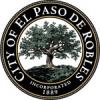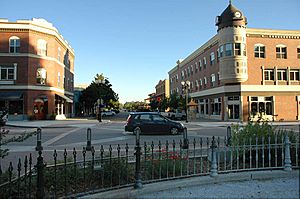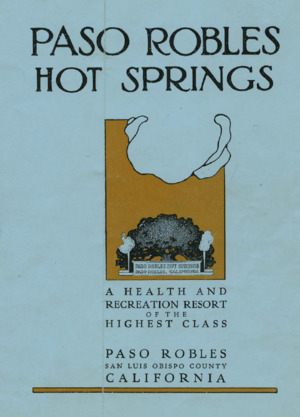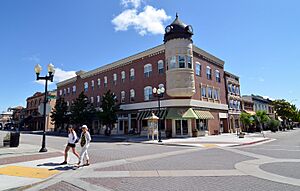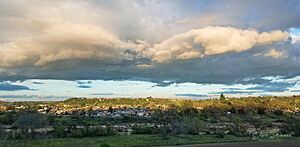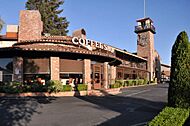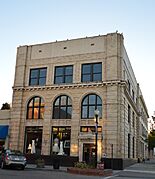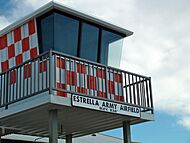Paso Robles, California facts for kids
Quick facts for kids
Paso Robles, California
|
|||
|---|---|---|---|
| City of El Paso de Robles | |||

Overlooking southern Paso Robles
|
|||
|
|||
| Nickname(s):
Paso
|
|||
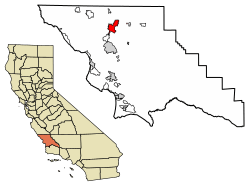
Location of El Paso de Robles (Paso Robles) in San Luis Obispo County, California
|
|||
| Country | United States | ||
| State | California | ||
| County | San Luis Obispo | ||
| Incorporated | March 11, 1889 | ||
| Named for | Spanish for the Pass of the Oaks | ||
| Government | |||
| • Type | Council–manager | ||
| • Body | El Paso de Robles City Council | ||
| Area | |||
| • Total | 19.66 sq mi (50.92 km2) | ||
| • Land | 19.65 sq mi (50.89 km2) | ||
| • Water | 0.01 sq mi (0.03 km2) 1.57% | ||
| Elevation | 732 ft (223 m) | ||
| Population
(2020)
|
|||
| • Total | 31,490 | ||
| • Density | 1,602.5/sq mi (618.7/km2) | ||
| Time zone | UTC−8 (Pacific) | ||
| • Summer (DST) | UTC−7 (PDT) | ||
| ZIP codes |
93446, 93447
|
||
| Area code | 805/820 | ||
| FIPS code | 06-22300 | ||
| GNIS feature IDs | 254139, 2410415 | ||
Paso Robles (pronounced like PASS-oh ROH-buhlz) is a city in San Luis Obispo County, California. Its full official name is El Paso de Robles, which means "The Pass of the Oaks" in Spanish. The city is located on the Salinas River, about 30 miles (48 km) north of San Luis Obispo. Paso Robles is famous for its natural hot springs, many wineries, and almond farms. It also hosts the California Mid-State Fair every year. In 2020, about 31,490 people lived in Paso Robles.
Contents
- The Name of Paso Robles
- History of Paso Robles
- What is Paso Robles Like?
- People of Paso Robles
- Paso Robles Economy
- Arts and Culture in Paso Robles
- Getting Around Paso Robles
- Schools and Learning
- Media in Paso Robles
- Fun Things to Do in Paso Robles
- Famous People from Paso Robles
- Images for kids
- See also
The Name of Paso Robles
The city's full name, El Paso de Robles, means "The Pass of the Oaks" in Spanish.
Most people in the city say "PASS-oh ROH-buhlz". This is an English way of saying the name. The Spanish way to say it would be "PASS-oh ROH-blays".
History of Paso Robles
This area of the Central Coast has always been known for its warm, natural springs. Native Americans called the Salinan people lived here thousands of years ago. They knew this place as the "Springs" or "Hot Springs."
In 1857, James and Daniel Blackburn bought the land grant called Rancho Paso de Robles. Their partner, Drury James, was the uncle of the famous outlaw Jesse James. This land was a popular rest stop for travelers on the El Camino Real trail. It was well-known for its mineral hot springs. Priests from the nearby Mission San Miguel built the first mineral baths here. Over time, settlers came to Paso Robles. They started cattle ranches, grew apples and almonds, and planted vineyards.
In 1864, the first El Paso de Robles Hotel was built. It had a special bathhouse with hot mineral springs. Today, you can still find hot spring experiences at places like the Paso Robles Inn.
James and Daniel Blackburn gave two blocks of land to the city for a public park. This park was meant for everyone to enjoy. In 1890, a bandstand was built in the park.
When the Southern Pacific Railroad arrived in 1886, work began on planning the town around the hotel. A big celebration was held when the first train arrived. People came from San Francisco to buy land and enjoy daily barbecues.
In 1889, Paso Robles officially became a city. A new, large hotel was built. It was made of strong stone and was fireproof. This hotel, the El Paso de Robles Hotel, opened in 1891. It had a large garden, a golf course, a library, and many bath rooms with hot springs.
A famous musician, Ignace Paderewski, visited the hotel in 1914 for his arthritis. He loved the area so much that he later bought two ranches nearby. Many other famous people also stayed at the hotel, including President Theodore Roosevelt and actors like Clark Gable. Even baseball teams like the Pittsburgh Pirates used the hot springs to relax.
For a while, Paso Robles was known as the "Almond City." It had the most almond orchards in the world. Ranchers were very important to the area. They raised cattle and horses, and grew grains and fruits. Today, many of these old ranches and orchards are now vineyards.
To thank the ranchers, the city started Pioneer Day in 1931. This event is still celebrated every year on the second Saturday in October.
In 1940, a fire destroyed the El Paso de Robles Hotel. A new hotel, the Paso Robles Inn, was built in its place. It opened in 1942 and was designed for people traveling by car.
In 1955, the famous actor James Dean died in a car accident near Paso Robles. A memorial stands nearby for his fans.
Through the 1960s and 1970s, Paso Robles grew a lot. The wine industry became very popular, and the California Mid-State Fair became a big event. Nearby lakes, like Lake Nacimiento, became popular vacation spots.
In 1995, a new library and city hall building was finished. The famous writer Ray Bradbury spoke at its opening.
The Healing Hot Springs
Paso Robles has been known for its springs and mud baths since 1795. People called it "California's oldest watering place." By 1868, visitors came from far away to experience the healing waters. The Iron Spring and Sand Spring were said to create wonderful feelings.
In 1882, a pamphlet advertised the "Hot and Cold Sulphur Springs and the Only Natural Mud Baths in the World." The hotel offered nice rooms, a reading room, and a telegraph office. Guests could also stay in private cottages.
A bathhouse was built over the sulfur spring in 1888. It had a large pool and 37 private bath rooms. Later, a public bathhouse was built, offering baths for a low price. This spot is now the city's Municipal Pool.
Paso Robles Wine Country
The wine industry in Paso Robles has a long history. Spanish explorers and missionaries first planted grapevines here in 1797. The priests of the Mission San Miguel were the first winemakers. You can still see their old wine tools at the mission.
Commercial winemaking started in 1882. Andrew York, a settler from Indiana, planted vineyards and built the Ascension Winery. He found that the climate and soil were perfect for growing grapes.
Other families also started vineyards, like Gerd and Ilsabe Klintworth in 1886. They sold different types of wine, including some of the first white wine in the area. The Casteel Vineyards were planted before 1908.
After Prohibition ended, Lorenzo and Rena Nerelli opened the Templeton Winery in 1917. This was the first winery in the area to be officially licensed.
Many families came to Paso Robles in the 1920s to start vineyards. The Dusi family bought their vineyard in 1924. Their old Zinfandel vines are still growing today.
The famous musician Ignace Paderewski helped Paso Robles become known for wine. He bought land and planted grapes in the 1920s. His wines won awards, which helped establish Paso Robles as a top wine region.
The San Simeon Earthquake
On December 22, 2003, a strong earthquake hit near Paso Robles. It was a 6.6 magnitude earthquake. Sadly, two people died when the roof of the clock tower building in downtown Paso Robles collapsed.
The earthquake also brought the old underground springs back to life. This caused flooding and a large sinkhole in the parking lot of the city hall and library. The sinkhole was later filled in 2010. A new clock tower was built to remember the two women who died.
What is Paso Robles Like?
Paso Robles is located about halfway between the big cities of Los Angeles and San Francisco.
The city has gentle rolling hills to the east. To the west, there are taller foothills that lead up to the Santa Lucia Coastal Range. These areas are covered in dry grasslands and oak trees. Paso Robles is at the southern end of the fertile Salinas River Valley. It's about 24 miles (39 km) inland from the Pacific Ocean.
Paso Robles Weather
Paso Robles has a hot-summer Mediterranean climate. This means it has long, hot, dry summers and short, cool, rainy winters. The weather is great for growing grapes, olives, and almonds.
The city gets about 14.71 inches (374 mm) of rain each year, mostly in winter and early spring. It usually doesn't rain from May to September. Summers are very hot, often reaching over 100°F (38°C). But the nights are much cooler, sometimes dropping 50°F (28°C). This big temperature change helps certain types of grapes grow well.
Winters are cool and wet, with daytime temperatures around 50°F (10°C). Mornings and nights can be quite cold, sometimes reaching 22°F (-6°C). Fog can sometimes roll in from the ocean, but it usually clears up by mid-morning.
The hottest temperature ever recorded was 117°F (47°C) on August 13, 1933. The coldest was 0°F (-18°C) on January 6, 1913. Snow is rare, but it has fallen a few times, like 4 inches (10 cm) on December 15, 1988.
People of Paso Robles
In 2020, the population of Paso Robles was 31,490 people. The city has grown a lot over the years.
Paso Robles Economy
Wine and Vineyards
The Paso Robles Wine Country is a big part of the local economy. There are more than 250 wineries and many vineyards. Over 25 different types of grapes are grown here.
The Paso Robles Wine Country Alliance is a group that helps promote the wine region. They host many festivals and events to teach people about Paso Robles wines.
Green Building
Some companies in the area build homes using special methods. These include straw-bale construction, insulating concrete forms, and rammed earth. These methods help create buildings that are good for the environment.
Arts and Culture in Paso Robles
Paso Robles hosts many fun festivals throughout the year:
- The Zinfandel Festival in March celebrates local Zinfandel wines.
- The Paso Robles Wine Festival takes place in May.
- The Olive Festival in August offers free samples of olive oil and olive products.
- The Harvest Wine Weekend in October celebrates the grape harvest.
On Memorial Day Weekend, the Festival of the Arts is held in the downtown park. It features over 100 artists and celebrates the region's natural beauty.
Getting Around Paso Robles
Roads and Highways
Paso Robles is at an important crossroads for two major roads:
 U.S. Route 101 runs north and south through the city. It connects Paso Robles to San Jose and San Francisco to the north, and San Luis Obispo and Los Angeles to the south.
U.S. Route 101 runs north and south through the city. It connects Paso Robles to San Jose and San Francisco to the north, and San Luis Obispo and Los Angeles to the south. State Route 46 runs east and west. It connects the city to the Pacific Ocean in the west and the San Joaquin Valley in the east.
State Route 46 runs east and west. It connects the city to the Pacific Ocean in the west and the San Joaquin Valley in the east. State Route 229 is a smaller road that connects Paso Robles to other small towns in the eastern part of the county.
State Route 229 is a smaller road that connects Paso Robles to other small towns in the eastern part of the county.
Train Travel
Amtrak, the national passenger train system, has a station in Paso Robles. The Coast Starlight train stops here daily, traveling between Seattle and Los Angeles.
Airport
The Paso Robles Municipal Airport is a regional airport for smaller planes. It's about 5 miles (8 km) northeast of downtown. You won't find regular passenger flights here. However, it's used for business planes and general aviation.
The California Department of Forestry and Fire Protection (CAL FIRE) has an air attack base at the airport. This is where planes are refilled with chemicals to fight brush and forest fires. The local Civil Air Patrol also trains here. The California Highway Patrol (CHP) uses the airport for speed enforcement and search and rescue missions.
The airport also hosts the Northern California Regional Aerobatic Contest every June.
Water Supply
Paso Robles has a special water treatment plant. In 2023, the city approved a pipeline to send purified recycled water to vineyards and parks. This helps them use less groundwater.
Schools and Learning
The Paso Robles Public Schools District has several schools:
- Six elementary schools (K–5)
- One middle school (6–8)
- Three high schools
There are also private schools like Saint Rose of Lima School and Trinity Lutheran School. For higher education, Cuesta College has a campus here, along with the Paso Robles Adult School and the PR Culinary Arts Academy.
Media in Paso Robles
Local newspapers include the Paso Robles Daily News and Paso Robles Press. You can also find news about Paso Robles in the San Luis Obispo Tribune and on TV stations like KSBY TV and KEYT TV. The local radio station is KPRL-AM/1230.
Fun Things to Do in Paso Robles
Paso Robles offers many activities like cycling, golfing, tennis, and swimming. The city has hosted parts of the AMGEN Tour of California bike race. It also has an annual Wine Vine Run, a half marathon and 5k race that helps local high school sports.
Lake Nacimiento is a large lake about 13 miles (21 km) northwest of the city. It's a popular spot for waterskiing, wakeboarding, jet-skiing, fishing, and swimming.
Parks and Recreation
- Barney Schwartz Park: This 42-acre (17 ha) park has fields for baseball, softball, and soccer. It also has lake access, picnic areas, and playgrounds.
- Centennial Park: This 17-acre (6.9 ha) park is home to indoor sports like basketball and volleyball. It has a large swimming pool with waterslides, picnic areas, an amphitheater, walking paths, basketball courts, pickleball courts, and tennis courts.
- City Park: Located in the heart of downtown, this 5-acre (2.0 ha) park was donated by the city's founders. It's a popular spot for holiday events, concerts, farmers markets, and car shows.
- Sherwood Park: This park is mostly used for youth sports. It has a renovated Little League field, basketball courts, horseshoe pits, a sand volleyball court, barbecue areas, soccer fields, a softball field, and tennis courts. It also has a playground called Sherwood Forest.
Event Venues
- Paso Robles Event Center: This is where the California Mid-State Fair is held.
- Vina Robles Amphitheatre: An outdoor theater that opened in 2013.
- River Oaks Hot Springs Spa: An outdoor venue.
- Paso Robles Inn Ballroom: An indoor venue.
Famous People from Paso Robles
Many interesting people have connections to Paso Robles:
- Frank Armitage (1924-2016), a muralist and former Walt Disney imagineer.
- Dylan Beavers, a baseball player drafted by the Baltimore Orioles.
- Casey Biggs, an actor known for Star Trek: Deep Space Nine.
- Jason Botts, a former baseball player for the Texas Rangers.
- Christine Clayburg, a correspondent for Fox News Channel.
- Bailey Gaither, a professional wide receiver.
- Larry Grant, a former football coach.
- Dennis Harrah, a former NFL football player for the Los Angeles Rams.
- Terry Hoage, a former NFL player who now owns a vineyard in Paso Robles.
- Derrick Jasper, a former basketball player.
- Rusty Kuntz, a baseball player and coach who won the 1984 World Series and 2015 World Series.
- Frank Minini, an NFL player born in Paso Robles.
- Colleen Moore, an actress who died in Paso Robles.
- Josh Oliver, a professional tight end for the Jacksonville Jaguars and Baltimore Ravens.
- Ignacy Jan Paderewski, a world-famous Polish pianist and former Prime Minister of Poland.
- Don Parish (American football), a college football player.
- Hampton John "Hamp" Pool, a football player, coach, and scout.
- Hal Rhyne, a baseball player.
- Hunter Tylo, an actress who lives in Paso Robles.
- Mitchell Van Dyk, an NFL offensive tackle.
- Elena Verdugo, an actress with a star on the Hollywood Walk of Fame.
- King Vidor (1894–1992), a pioneering film director.
- Jake Zemke, a professional motorcycle racer.
Images for kids
See also
 In Spanish: El Paso de Robles para niños
In Spanish: El Paso de Robles para niños



